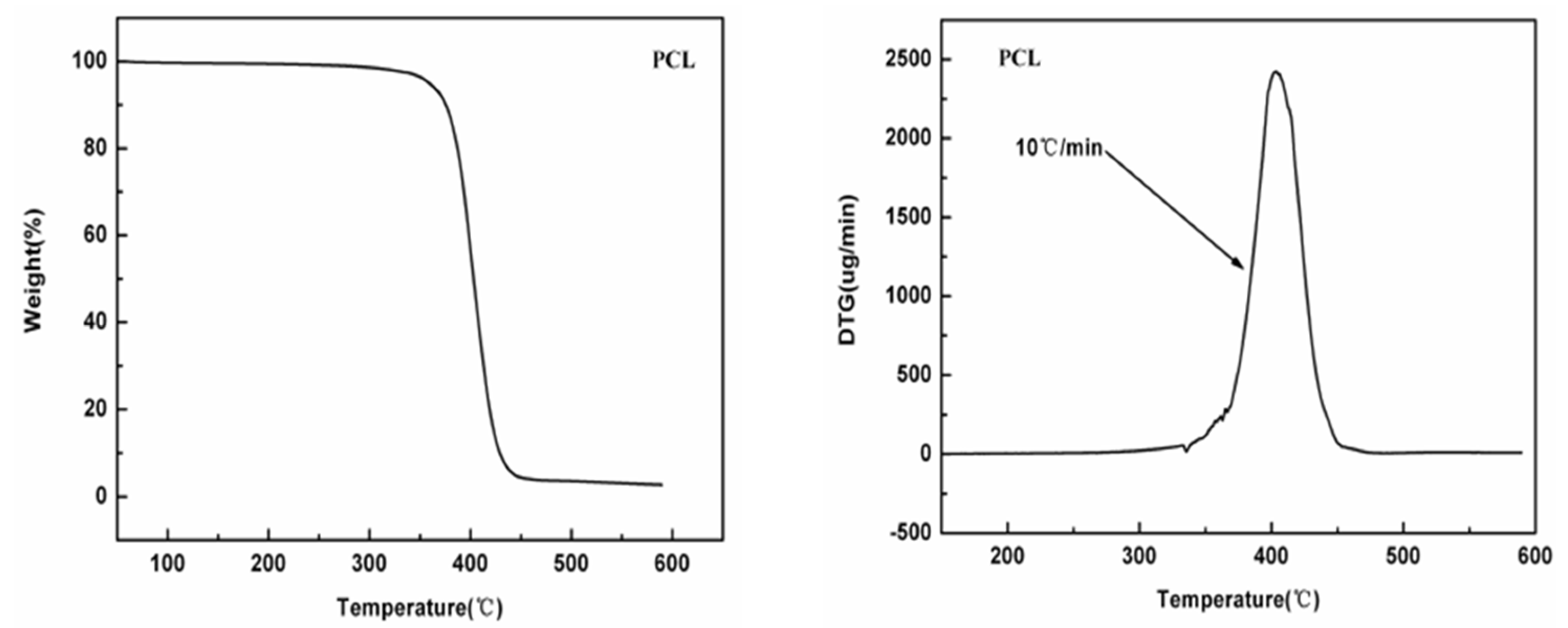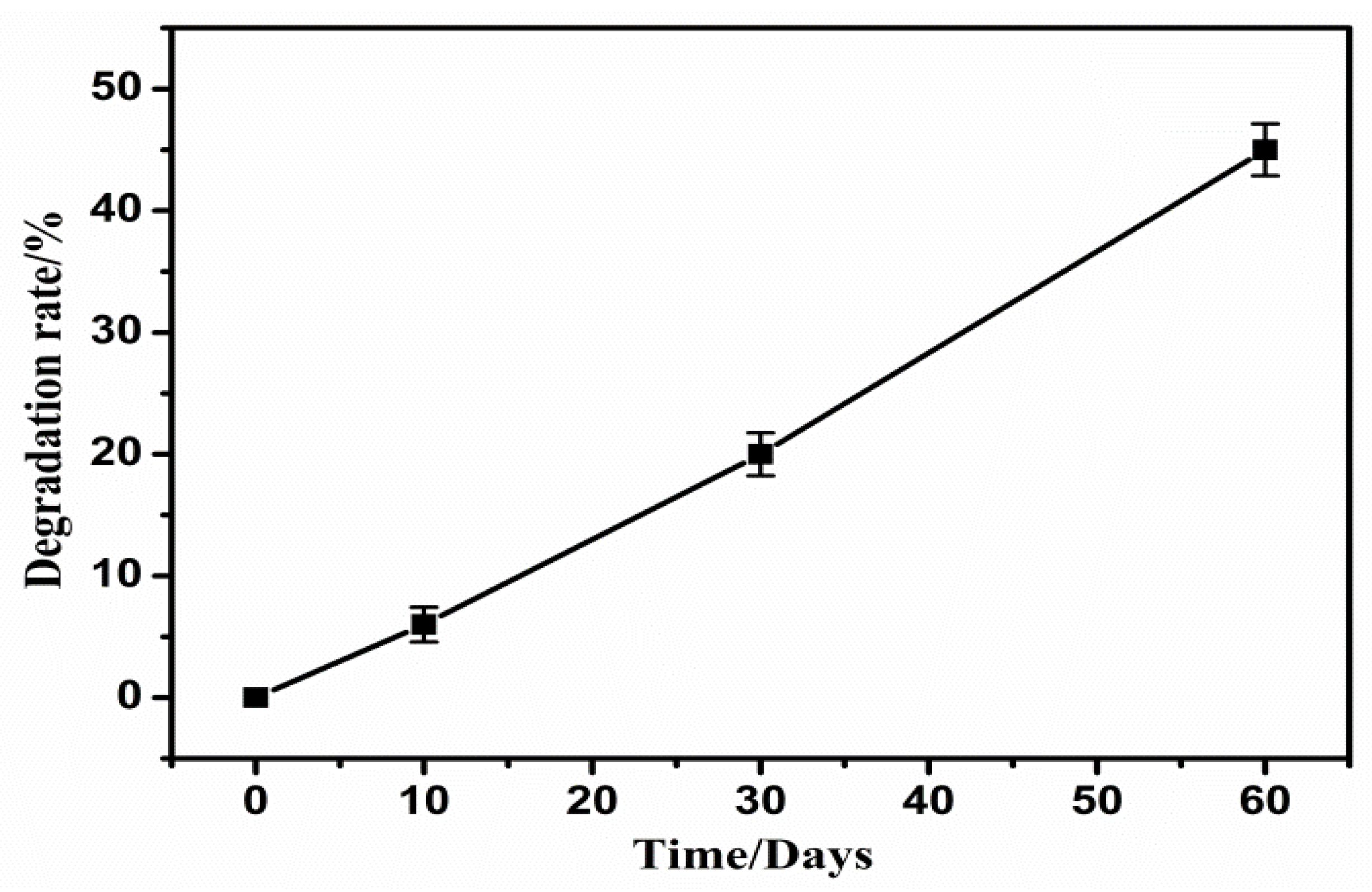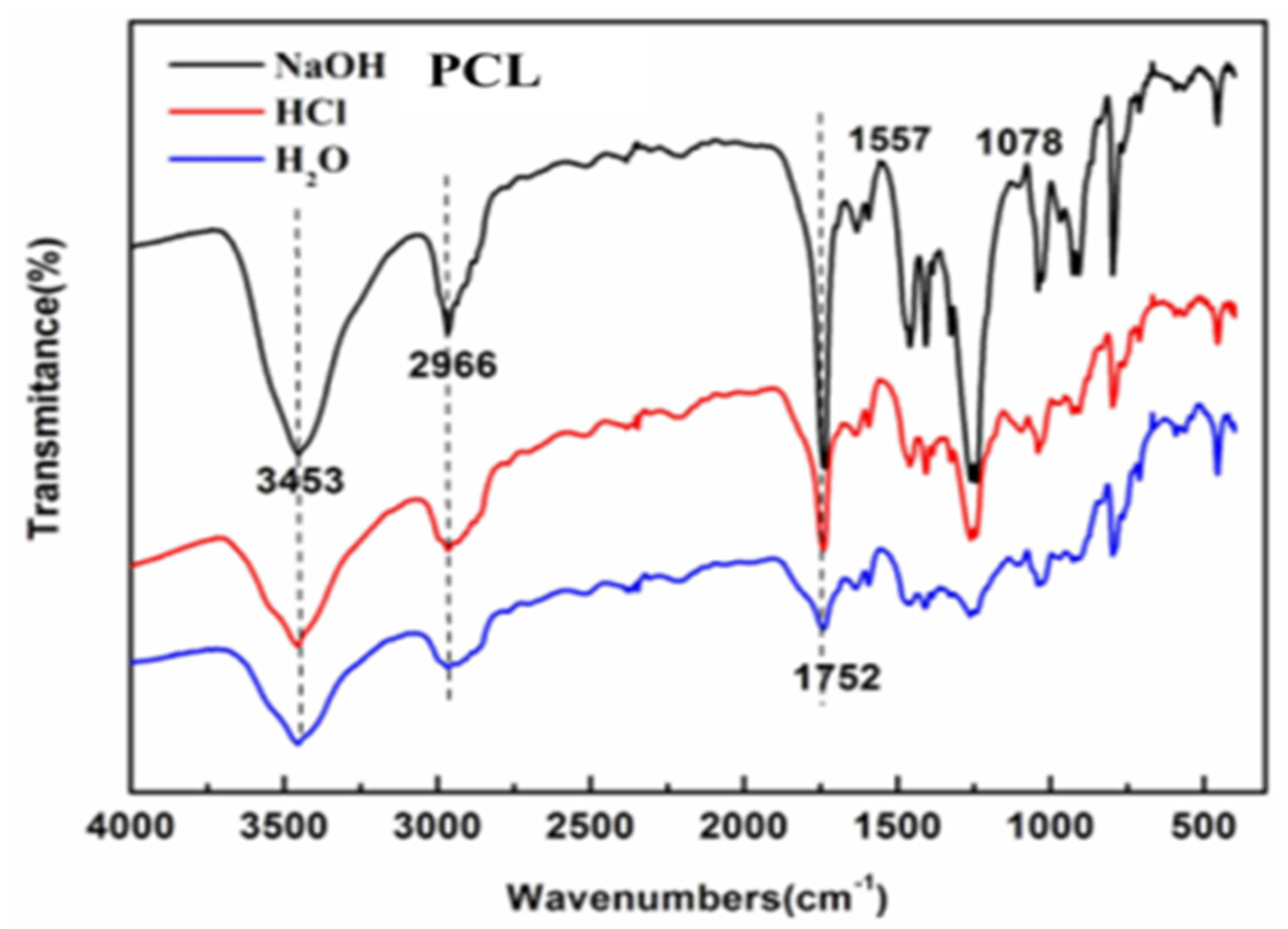Biodegradable Mulching Films Based on Polycaprolactone and Its Porous Structure Construction
Abstract
1. Introduction
2. Materials and Methods
2.1. Raw Materials
2.2. Equipment
2.3. Sample Preparation
2.4. Performance Testing and Structural Characterization
2.5. The Functional Performance of Mulching
3. Results and Discussion
3.1. Thermal Stability Analysis of Porous Film
3.2. Analysis of the Degradation Performance of PCL Mulch Film
3.3. Infrared Analysis of the Porous Film
3.4. Morphological Analysis of the Porous Film
3.5. Functional Performance for Mulching
4. Conclusions
Author Contributions
Funding
Acknowledgments
Conflicts of Interest
References
- Sun, D.; Li, H.; Wang, E.; He, W.; Hao, W.; Yan, C.; Li, Y.; Mei, X.; Zhang, Y.; Sun, Z.; et al. An overview of the use of plastic-film mulching in China to increase crop yield and water-use efficiency. Natl. Sci. Rev. 2020, 7, 1523. [Google Scholar] [CrossRef] [PubMed]
- Gao, H.; Yan, C.; Liu, Q.; Li, Z.; Yang, X.; Qi, R. Exploring optimal soil mulching to enhance yield and water use efficiency in maize cropping in China: A meta-analysis. Agric. Water Manag. 2019, 225, 105741. [Google Scholar] [CrossRef]
- Kasirajan, S.; Ngouajio, M. Polyethylene and biodegradable mulches for agricultural applications: A review. Agron. Sustain. Dev. 2012, 32, 501. [Google Scholar] [CrossRef]
- Yang, N.; Feng, L.; Li, K.; Feng, C.; Sun, Z.; Liu, J. The degradable time evaluation of degradable polymer film in agriculture based on polyethylene film experiments. e-Polymers 2021, 21, 821–829. [Google Scholar] [CrossRef]
- Wang, K.; Sun, X.; Long, B.; Li, F.; Yang, C.; Chen, J.; Ma, C.; Xie, D.; Wei, Y. Green Production of Biodegradable Mulch Films for Effective Weed Control. ACS Omega 2022, 6, 32327. [Google Scholar] [CrossRef]
- Halley, P.; Rutgers, R.; Coombs, S.; Kettels, J.; Gralton, J.; Christie, G.; Jenkins, M.; Beh, H.; Griffin, K.; Jayasekara, R.; et al. Developing biodegradable mulch films from starch-based polymers. Starch-Starke 2001, 53, 362–367. [Google Scholar] [CrossRef]
- Raghavan, D. Characterization of biodegradable plastics. Polym.-Plast. Technol. Eng. 1995, 34, 41–63. [Google Scholar] [CrossRef]
- Akhir, M.; Mustapha, M. Formulation of Biodegradable Plastic Mulch Film for Agriculture Crop Protection: A Review. Polym. Rev. 2022, 62, 890. [Google Scholar] [CrossRef]
- Costa, R.; Saraiva, A.; Carvalho, L. The use of biodegradable mulch films on strawberry crop in Portugal. Sci. Hortic. 2014, 173, 65–70. [Google Scholar] [CrossRef]
- Tan, Z.; Yi, Y.; Wang, H.; Zhou, W.; Yang, Y.; Wang, C. Physical and Degradable Properties of Mulching Films Prepared from Natural Fibers and Biodegradable Polymers. Appl. Sci. 2016, 6, 147. [Google Scholar] [CrossRef]
- Luckachan, G.E.; Pillai, C.K.S. Biodegradable polymers—A review on recent trends and emerging perspectives. J. Polym. Environ. 2011, 19, 637–676. [Google Scholar] [CrossRef]
- Qiao, R.; Wang, X.; Qin, G.; Liu, Q.; Liu, J.; He, W. Preparation of Organic Crystal Seed and Its Application in Improving the Functional Period of Biodegradable Agricultural Film. Crystals 2021, 11, 826. [Google Scholar] [CrossRef]
- Qiao, R.M.; Zhao, C.P.; Liu, J.L.; Zhang, M.L.; He, W.Q. Synthesis of Novel Ultraviolet Absorbers and Preparation and Field Application of Anti-Ultraviolet Aging PBAT/UVA Films. Polymers 2022, 14, 1434. [Google Scholar] [CrossRef]
- Qiao, R.; Wang, X.; Qin, G.; Liu, J.; Cao, A.; Ouyang, C.; He, W. Degradation Mode of PBAT Mulching Film and Control Methods during its Degradation Induction Period. Mini-Rev. Org. Chem. 2022, 19, 608–616. [Google Scholar] [CrossRef]
- Liu, Q.; Wang, Y.; Liu, J.; Liu, X.; Dong, Y.; Huang, X.; Zhen, Z.; Lv, J.; He, W. Degradability and Properties of PBAT-Based Biodegradable Mulch Films in Field and Their Effects on Cotton Planting. Polymers 2022, 14, 3157. [Google Scholar] [CrossRef] [PubMed]
- Deng, L.; Yu, Y.; Zhang, H.; Wang, Q.; Yu, R. The Effects of Biodegradable Mulch Film on the Growth, Yield, and Water Use Efficiency of Cotton and Maize in an Arid Region. Sustainability 2020, 11, 7039. [Google Scholar] [CrossRef]
- Zhang, W.; Ji, J.H.; Zhao, J.; Wang, X.; Xu, Y.; Yang, B.; Wang, P. Progress of biomass-based poly (butylenes succinate) (PBS). New Chem. Mat. 2010, 38, 1–5. (In Chinese) [Google Scholar]
- Tokiwa, Y.; Calabia, B.P. Biodegradability and biodegradation of poly (lactide). Appl. Microbiol. Biotechnol. 2006, 72, 244–251. [Google Scholar] [CrossRef]
- Sridewi, N.; Bhubalan, K.; Sudesh, K. Degradation of commercially important polyhydroxyalkanoates in tropical mangrove ecosystem. Polym. Degrad. Stab. 2006, 91, 2931–2940. [Google Scholar] [CrossRef]
- Zhang, G.D.; Yang, J.Y.; Feng, X.D.; Gu, Z.W. Progress in study of polylactides. Progr. Chem. 2000, 12, 89–102. (In Chinese) [Google Scholar]
- Kaygorodov, K.; Tarabanko, V.; Tarabanko, N. Thermodynamics of a-angelicalactone polymerization. Cogent Chem. 2018, 4, 1443689. [Google Scholar] [CrossRef]
- Kaygorodov, K.; Tarabanko, V.; Chernyak, M.; Kondrasenko, A.; Tarabanko, N. Synthesis of Copolymers of Furandicarboxylic Acid, Ethylene Glycol, and Poly(Angelica Lactone). J. Sib. Fed. Univ. Chem. 2016, 3, 345–352. [Google Scholar] [CrossRef]
- Kazachenko, A.S.; Vasilieva, N.Y.; Borovkova, V.S.; Fetisova, O.Y.; Issaoui, N.; Malyar, Y.N.; Elsuf’Ev, E.V.; Karacharov, A.A.; Skripnikov, A.M.; Miroshnikova, A.V.; et al. Food Xanthan Polysaccharide Sulfation Process with Sulfamic Acid. Foods 2021, 10, 2571. [Google Scholar] [CrossRef]
- Wu, J.; Xie, B.J. Study of starch/PCL thermoplastic full-biodegradable film. China Plast. Ind. 2002, 30, 22–24. (In Chinese) [Google Scholar]
- Ohtaki, A.; Akakura, N.; Nakasaki, K. Effects of temperature and inoculum on the degradability of poly-ε-caprolactone during composting. Polym. Degrad. Stab. 1998, 62, 279–284. [Google Scholar] [CrossRef]
- Magharla, D.D.; Rajadas, J.; Chandrasekar, V. Influence of manufacturing parameters on development of contraceptivesteroid loaded injectable microspheres. Chem. Pharm. Bull. 2004, 52, 976–980. [Google Scholar]
- Kikkawa, Y.; Suzuki, T.; Tsuge, T.; Kanesato, M.; Doi, Y.; Abe, H. Phase structure and enzymatic degradation of poly(L-lactide)/atactic poly(3-hydroxybutyrate) blends: An atomic force microscopy study. Biomacromolecules 2006, 7, 1921–1928. [Google Scholar] [CrossRef]
- Venkatesan, J.; Qian, Z.; Ryua, B.; Kumar, N.A.; Kim, S.-K. Preparation and characterization of carbon nanotube-grafted-chitosan—Natural hydroxyapatite composite for bone tissue engineering. Carbohydr. Polym. 2011, 83, 567–577. [Google Scholar] [CrossRef]
- Patrício, T.; Domingos, M.; Gloria, A.; Bártolo, P. Characterisation of PCL and PCL/PLA scaffolds for tissue engineering. Procedia CIRP 2013, 5, 110–114. [Google Scholar] [CrossRef]
- Zarina, S.; Ahmad, I. Biodegradable composite films based on κ-carrageenan reinforced by cellulose nanocrystal from kenaf fibers. BioResources 2014, 10, 256–271. [Google Scholar] [CrossRef]
- Wang, J.; Tian, Y.; Zhou, B. Degradation and Stabilization of Poly(Butylene Adipate-co-Terephthalate)/Polyhydroxyalkanoate Biodegradable Mulch Films Under Different Aging Tests. J. Polym. Environ. 2022, 30, 1366. [Google Scholar] [CrossRef]
- Miguel, A.; Cristina, P.; Jose, M.F.; Marina, P.A.; Juan, L.-M. Films Based on Mater-Bi® Compatibilized with Pine Resin Derivatives: Optical, Barrier, and Disintegration Properties. Polymers 2021, 13, 1506. [Google Scholar]
- Dragana, K.; Paula, M.; Nikola, J. Biodegradable Nonwoven Agrotextile and Films—A Review. Polymers 2022, 14, 2272. [Google Scholar]
- Touchaleaume, F.; Martin-Closas, L.; Angellier-Coussy, H.; Chevillard, A.; Cesar, G.; Gontard, N.; Gastaldi, E. Performance and environmental impact of biodegradable polymers as agricultural mulching films. Chemosphere 2016, 144, 433–439. [Google Scholar] [CrossRef] [PubMed]
- Zhao, A.Q. Effects of Soil Moisture and Temperature on the Degradation of Biodegradable Plastic Films and Its Filed Field Application. Master’s Thesis, China Agricultural University, Beijing, China, 2005. (In Chinese). [Google Scholar]
- Wu, S.; Gao, W.C.; Cai, K.; Jiao, J.G.; Zhang, S.X. The impact of soil moisture on degradation of biodegradable PBAT mulching films. J. Irrig. Drain. 2020, 39, 43–50. (In Chinese) [Google Scholar]
- Kijchavengkul, T.; Auras, R.; Rubino Ngouajio, M.; Fernandez, R.T. Assessment of aliphatic–aromatic copolyester biodegradable mulch films. Part II: Laboratory simulated conditions. Chemosphere 2008, 71, 1607–1616. [Google Scholar] [CrossRef] [PubMed]
- Sheikholeslami, S.N.; Rafizadeh, M.; Taromi, F.A.; Shirali, H.; Jabbari, E. Material properties of degradable Poly(butylene succinate-co-fumarate) copolymer networks synthesized by polycondensation of pre-homopolyesters. Polymer 2016, 98, 70–79. [Google Scholar] [CrossRef]
- Pastorino, L.; Pioli, F.; Zilli, M.; Converti, A.; Nicolini, C. Lipase-catalyzed degradation of poly (ε-caprolactone). Enzym. Microb. Technol. 2004, 35, 321–326. [Google Scholar] [CrossRef]
- Villena, J.; Moreno, M.M.; González-Mora, S.; López-Perales, J.A.; Morales-Rodríguez, P.A.; Moreno, C. Degradation Pattern of Five Biodegradable, Potentially Low-Environmental-Impact Mulches under Laboratory Conditions. Polymers 2022, 12, 1910. [Google Scholar] [CrossRef]
- DB 46/T519-2020; Biodegradable Plastics Products-Rapid Test Method Using Infrared/Raman Fingerprint Spectra. Hainan Provincial Market Supervision Administration: Hainan, China, 2020.
- Zhao, G.; Liu, J.; Liu, M.; Han, X.; Peng, Y.; Tian, X.; Liu, J.; Zhang, S. Synthesis of Molecularly Imprinted Polymer via Emulsion Polymerization for Application in Solanesol Separation. Appl. Sci. 2020, 10, 2868. [Google Scholar] [CrossRef]
- Zheng, Q.; Fang, L.; Guo, H.; Yang, K.; Cai, Z.; Meador, M.A.; Gong, S. Highly Porous Polymer Aerogel Film-Based Triboelectric Nanogenerators. Adv. Funct. Mater. 2018, 28, 1706365. [Google Scholar] [CrossRef]





| Thickness (μm) | Temperature of Soils (°C) | Temperature Difference with PE Film (°C) | Water Vapor Transmission Rate (gm−2Day−1) | Weed Biomass (kg m−2) | |
|---|---|---|---|---|---|
| PCL porous film | 11.09 | 17.81 | −0.21 | 637 | 0.35 |
| PCL film | 10.93 | 17.42 | 0.60 | 786 | 0.68 |
| PBAT film | 11.05 | 17.50 | −0.52 | 890 | 0.63 |
| PE film | 10.81 | 18.02 | 0 | 50 | 0.2 |
Publisher’s Note: MDPI stays neutral with regard to jurisdictional claims in published maps and institutional affiliations. |
© 2022 by the authors. Licensee MDPI, Basel, Switzerland. This article is an open access article distributed under the terms and conditions of the Creative Commons Attribution (CC BY) license (https://creativecommons.org/licenses/by/4.0/).
Share and Cite
Yang, N.; Ying, L.; Li, K.; Chen, F.; Zhao, F.; Sun, Z.; Feng, L.; Liu, J. Biodegradable Mulching Films Based on Polycaprolactone and Its Porous Structure Construction. Polymers 2022, 14, 5340. https://doi.org/10.3390/polym14245340
Yang N, Ying L, Li K, Chen F, Zhao F, Sun Z, Feng L, Liu J. Biodegradable Mulching Films Based on Polycaprolactone and Its Porous Structure Construction. Polymers. 2022; 14(24):5340. https://doi.org/10.3390/polym14245340
Chicago/Turabian StyleYang, Ning, Li Ying, Kaiyu Li, Feng Chen, Fengyan Zhao, Zhanxiang Sun, Liangshan Feng, and Jialei Liu. 2022. "Biodegradable Mulching Films Based on Polycaprolactone and Its Porous Structure Construction" Polymers 14, no. 24: 5340. https://doi.org/10.3390/polym14245340
APA StyleYang, N., Ying, L., Li, K., Chen, F., Zhao, F., Sun, Z., Feng, L., & Liu, J. (2022). Biodegradable Mulching Films Based on Polycaprolactone and Its Porous Structure Construction. Polymers, 14(24), 5340. https://doi.org/10.3390/polym14245340







